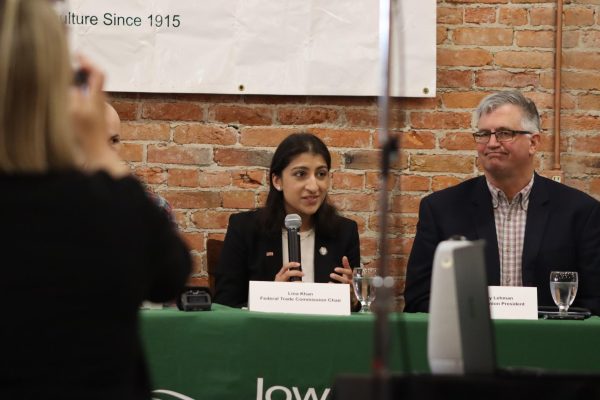Livestock diet plan research may improve air quality, odor
October 12, 2004
There’s something in the air at the new Animal Emission Laboratory.
After two years of construction, the laboratory is ready to research the link between livestock diets and gas emissions.
The goal of the livestock gas emission research is to determine if dietary changes in livestock can reduce gas emissions from animals in livestock facilities, said Wendy Powers, associate professor of animal science and environmental extension specialist.
Animals are fed a new, low-protein diet in which protein is substituted for various amino acids. This new diet may prove to be more costly for livestock producers because of to the cost of substituted amino acids, Powers said.
Results of the research may lead to new diet recommendations that could positively affect air quality, odor and livestock health, she said.
Powers said the lab is the only one if its kind in the country that offers this amount of flexibility. With eight rooms for housing and analyzing animal gas emissions, the lab is different because it is the only lab in the country designed to house more than one animal species at a time.
“We have eight larger rooms that have interchangeable penning and watering systems that allow us to put any livestock species in there,” Powers said.
Research elements such as the penning, feeding and water-handling systems and manure-handling apparatus can be removed from each room to accommodate the needs of different species, she said.
Powers said they plan to collect data on swine, broilers, laying hens, horses, cows, heifers and turkeys.
Since the opening of the lab on Sept. 14, it has housed 48 pigs — six per room, she said. Powers said it was important to start the livestock emission studies with swine because they are one of the most important livestock products in Iowa.
“Iowa is the No. 1 pork-producing state,” Powers said. “We thought it was important to right off the bat address the needs of the state.”
Sarah Bastyr, assistant scientist of animal science and lab manager, said it was also important to begin the research with swine because of the current climate.
“Swine require less heat, so we are studying them now because it works best with the current temperature,” Bastyr said.
She said they will begin to study baby chickens in the spring because they survive better in warmer temperatures.
Powers said they will only be testing one species of animal at a time for the next few months in order to establish baseline data. Studying multiple species at one time will follow shortly in order to make the best use of the facility, she said.
Five flocks of broiler and layer hens will be studied next spring and dairy cows will be studied next winter, Powers said. She said animals will be studied until they reach their market weight.
The air entering and leaving the eight rooms is monitored for 30-minute periods. Airflow rates going into and out of the rooms are measured, which calculates the emission rate of each gas.
Room temperatures are set independently and determine the airflow rate in each room. Room temperature and humidity are monitored every two seconds.
Bastyr said the rooms are monitored very closely and personnel can be alerted of any change in temperature or humidity immediately.
“We set up alarms to let us know if the chamber temperature is out of range,” Bastyr said.
“If it is out of range, an alarm goes off and triggers a series of phone calls to laboratory personnel.”
The ISU College of Agriculture, the Department of Animal Science, small businesses and private donations funded the lab, with the total amount reaching $700,000. The U.S. Department of Agriculture is currently funding the Animal Emission Laboratory’s research on swine.
















